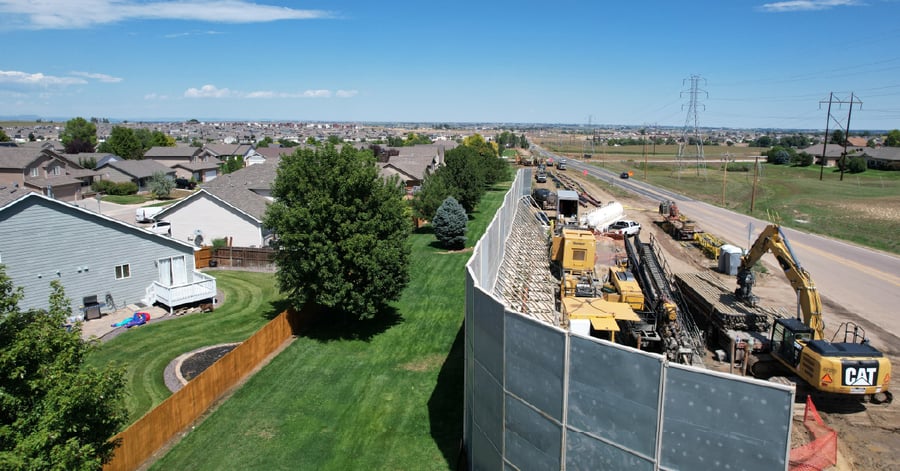
Navigating Noise Ordinances: A Complete Guide for Horizontal Directional Drilling
Matt R. Cott
Horizontal directional drilling (HDD) makes it possible to install pipelines and cables without digging trenches. It’s an ideal solution, especially for developed, residential areas. However, there’s still the issue of noise.
If not properly managed, HDD operations can cause serious disruption, resulting in complaints and fines. But with the right approach to noise ordinance compliance, you can keep your project moving forward while maintaining good relationships with the community.
The Patchwork Problem of Local Noise Ordinances
Here's what makes noise compliance tricky: there's no one-size-fits-all solution. Every municipality has its own sound ordinances with different decibel limits, measurement methods, and enforcement approaches.
Some cities enforce strict noise curfew hours, while others focus on maximum decibel levels regardless of time. For example, the city of Boston limits noise to:
- Anything louder than 50 decibels from 11 p.m. to 7 a.m.
- Anything louder than 70 decibels at any time, except for permitted construction.
Rural areas might have more lenient standards, but don't assume that means zero oversight. Even in less populated regions, a single noise complaint can trigger enforcement action.
For projects crossing state lines or requiring FERC approval, you're looking at layers of regulations that need careful navigation. The Federal Energy Regulatory Commission oversees interstate natural gas pipeline construction and operation, which typically include many HDD locations.
FERC's environmental review process requires detailed noise assessments through Resource Report 9, which must demonstrate how your project will comply with their strict limits around noise-sensitive areas (NSAs) like homes, schools, and hospitals.
What makes FERC compliance particularly challenging is that this isn't just about meeting a number — it's about documenting your entire noise management approach. You'll need to establish baseline ambient sound levels, predict construction and operational noise impacts, and prove your mitigation strategies will work. The review process involves not just FERC staff but also interagency review and public input, meaning your noise management plan may need to withstand scrutiny from multiple angles.
Understanding Your Noise Footprint
Before you can manage noise, you need to know what you're dealing with. Documenting baseline conditions and predicted impacts is essential for both compliance and project planning. HDD operations can generate noise levels ranging from 85 to over 100 decibels, depending on equipment and conditions.
Drilling rigs and power units are among the loudest components of your operation. These noise levels are well above typical residential limits.
Mud pumps and recycling systems add another layer of continuous noise. These systems run throughout your operation, creating what neighbors perceive as a constant drone.
Support equipment like generators, compressors, and truck traffic contributes to the overall noise. While individually manageable, the cumulative effect can push you over compliance limits.
Plan First, Drill Second: The Value of Noise Impact Assessments
Smart project managers know that a pre-construction noise assessment isn't just paperwork — it's insurance against project delays and community backlash. This is especially critical for environmental inspectors who need to ensure compliance throughout the project lifecycle.
A proper assessment maps out baseline noise levels, identifies noise-sensitive areas, and models how your operation will affect the acoustic environment. This data becomes your roadmap for both compliance documentation and community relations. More importantly, it helps you identify potential issues before they become actual problems.
Practical Noise Mitigation That Actually Works
Once you know your noise challenges, you can implement targeted solutions:
Modern sound barriers can significantly reduce noise levels when properly installed. The key is proper height, placement, and material selection applicable in frequencies that produce the most intrusive noise from equipment. A barrier that's too short or has gaps is just expensive decoration.
Equipment selection and smart scheduling can also help you avoid noise complaints. Newer, well-maintained equipment runs quieter. Plus, running your loudest operations during peak daytime hours — when ambient noise is higher — can mask the disruption.
Distance and orientation matter more than many site managers realize. Simply rotating equipment so exhaust points away from sensitive receptors can make the difference between compliance and violations.
Learning From the Field: Real-World Success Stories
Environmental Noise Control was brought in to assist on a large-scale horizontal directional drilling pipeline project, located close to residential areas. This created immediate noise concerns. Making matters more complex, the construction process required equipment to move frequently throughout the site, rendering fixed noise barriers impractical as the only noise mitigation solution.
In addition to a beam and panel sound wall, ENC provided 24-foot freestanding SK8 sound barrier panels. These barriers, specifically engineered for low-frequency and heavy-duty applications, were strategically positioned to shield residential areas from construction noise. Their modular design allowed crews to quickly reconfigure the barriers as equipment moved through different phases of the pipeline installation.
As a result, sound levels at nearby residences dropped to within acceptable limits, effectively minimizing community disturbance and complaints. Most importantly, this solution kept the project in compliance with local noise ordinances from start to finish.

Making Compliance Work for Your Bottom Line
Here's what many environmental managers and compliance teams miss: effective noise management isn't just about avoiding fines. It's about maintaining productivity and protecting your project timeline. Projects that get shut down for noise violations face costs far exceeding any mitigation investment.
That's where specialized expertise pays dividends. Environmental Noise Control's approach combines engineering precision with practical field experience. We don't just hand you a report — we provide actionable solutions that keep your project moving.
Our noise mitigation services start with comprehensive assessments that identify exactly what you're up against. We then design custom mitigation strategies using proven materials and methods. Most importantly, we verify results to ensure ongoing compliance.
The Path Forward
Ready to ensure your next HDD project stays compliant and on schedule? See how our comprehensive noise management services can support compliance and protect your project timeline.

